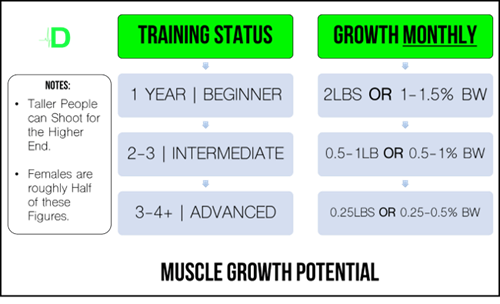
How to build muscle while staying lean
What is the common perception that most people have of a personal trainer? A big ripped guy wearing a tee shirt two sizes too small, to show off his big guns. He’s orange from fake tan, spends too much time looking at himself in the mirror and always seems to have a protein shaker cup in one hand. Or there’s the female equivalent who struts around in skin tight lycra hot pants and crop tops, flexing her abs and taking gym mirror selfies more often than can be considered normal.
Why is this? Because most people get into training for one of two reasons, to lose fat and build muscle and personal trainers are no exception to this. Yes, it’s a cliché but this really does seem to be the main public perception of trainers in this country and the industry seems to do little to dispel that.
Let’s face it, most people go to the gym to change the way they look and if the above aesthetic is what you desire then who am I to judge?
Right, so now that I have offended everyone and marginalised my readership with my crass generalization those of you who are still reading are about to learn everything you need to know in order to get shredded. Fake tan, shaker cups and booty shots optional.
Why build muscle?
This is actually a really important question and one I’m not sure that many people ask themselves. There are good and bad reasons for doing anything and building muscle is no different. If you want to get big muscles because you feel inadequate in some way and you mistakenly believe that being ‘hench’ will make you a better person. Newsflash, not only will it not make you a better person, if you aren’t already comfortable in your own skin the pursuit of muscularity could send you down a dark path.
That being said, there is nothing wrong with wanting to put on a little extra lean mass and, in fact, it can have many benefits, not least of all making you less injury prone. Especially if there is a risk of impact in your sport. Lean mass requires more energy, so you will burn more calories at rest and have a higher metabolic rate, meaning that you can eat more than someone of equal weight but higher body fat percentage.
You look better naked and that does wonders for your self-confidence and for your sex life. Yeah, that sounds shallow but if you ask anyone in any gym around the country why they are training, I’m willing to bet that you could trace the answer of 90% of people back to the fact that they want to get laid.
Of course, more muscle tends to come with more strength and that has obvious benefits, especially if you are a recreational athlete. In fact, I would always recommend that you do strength training to support a sporting goal rather than to simply look better, it just makes the goal more meaningful and the journey more enjoyable.
How much muscle can you build?

If you are a beginner you can expect reasonable gains in your first year, up to around 25lbs of muscle. After that your growth potential slows down quite considerably so it’s really important to have realistic expectations. It’s these unrealistic expectations that lead to a lot of young blokes using *ahem* short cuts, if you get what I mean.


Just look at actor Hugh Jackman. The difference in his physique between his first appearance as Wolverine in the X-Men and his last outing in Logan shows an incredible change in his physique, except these images are 16 years apart… SIXTEEN YEARS! Much like fat loss, hypertrophy doesn’t happen overnight.
Some people might claim that Hugh’s physique isn’t as impressive as, say, Ronnie Coleman but so what? Hugh is natural and, in fact, I would suggest that with the right approach and without having to get too obsessive it’s quite an achievable physique for most blokes. Don’t forget that he will lean down for the film to make his abs pop out and he also uses water loading to make him look more vascular in certain scenes.
These are simple tricks of the trade that are often used by physique models to get the ripped appearance they require for a photoshoot, so don’t be fooled into thinking that anyone walks around the streets looking that buff and if they do, they’re almost certainly not natural.
How to get ripped
I’m guessing that you are using weights to achieve the physique that you desire and if you aren’t then that is the first thing you need to change. I’m sorry, but bodyweight training will only get you so far and even Frank Medrano barely fills out a medium sized tee shirt.
When it comes to research on training for muscular hypertrophy there isn’t a lot, it’s technically still an experimental theory based procedure. But, if you want to know more about the research side of things Brad Schoenfeld is your man.
In 2010 he released a review of the available research and came up with a pretty definitive protocol for training for muscle size, I’m not getting into the more complex aspects like different periodisation models or any of the more convoluted methods of training with bands, etc. Let’s keep things nice and simple because if you aren’t already getting the results you want you aren’t getting the basics right.
Rep ranges
There are three main rep ranges: low = 1-5 reps medium = 6-12 reps high = 15+. The lower end is generally considered ideal for strength training, although strength and size do go hand in hand and some people respond well to this stimulus, it’s generally regarded that the moderate range of 6-12 reps is better for hypertrophy so this is where you ought to be shooting for. The higher rep ranges have the worst return in relation to getting ripped, but are great for muscular endurance which is important for injury prevention so you might want to include some of these in your accessory work.
Rest periods
Again, there are three ranges here: short = <30seconds, medium = 60-90 seconds, long = 2-3 minutes. Again, the moderate range of 60-90 seconds is recommended. There are benefits to longer rest intervals especially if you are performing for reps to failure but, as good as the rest time is for recovery from fatigue it may blunt some of the anabolic adaptations to training stimulus.
Exercise selection
Exercises that recruit multiple muscle groups and use multiple joints will result in more adaptation and, obviously, more muscle fibre recruitment. But there is still a place for isolation exercises, especially if you want to target grow a certain body part like quads, biceps or abs, for example (I know you love your beach muscles). Ideally aim for prime movements; push, pull, squat, hinge, rotation, anti-rotation, loaded carries. These movement patterns are involved in compound lifts like squats, deadlifts and bench press. So, base your workouts around 2-3 compound lifts and a bunch of accessory work to address weaknesses and isolation work to target body parts. The more ranges of movement you incorporate into your training the more muscle fibres are stimulated and the more muscle growth you will see. Getting this right will make a huge difference so now you can stop doing an hour of bicep curls and start putting some productive work in instead.
Aim for volume
The more volume you put into your workouts the more stimulus you put your muscles through. So, you could technically do multiple sets of low reps and high weights if that style of training suits you but you’d want to be shooting for a minimum of 25 reps per lift and 60-100 reps per muscle group per week. Ideally, a moderate intensity level (when we talk about intensity in strength training we mean load) that allows you to work within the 6-12 rep range I mentioned earlier and 2-4 sets of each exercise. Around 75% of 1 rep max is perfect. Periodized training cycles bring great rewards and reduce the onset of over training syndrome (although this is more common with very high intensity training especially if training to failure on all sets).
A 6 to 8-week block starting off at about 50% 1RM and building up maybe as much as 90% 1RM for a brief period of functional overreaching, including a set or two of reps to failure. Follow this with a taper or de-load week or two and then reassess your 1RM and start again.
Time under tension
This is a well-known concept now but I still see young lads in commercial gyms who don’t get this. Swinging their weights around like they’re deliberately trying to herniate a couple discs in their lumbar spine. Using smooth and controlled reps will stimulate more muscle fibres and even cause your body to create more fibres, which is, after-all, what you want when looking to get ripped. A concentric muscle contraction is where the muscles shorten, like flexing the elbow into an arm curl. Aim for 1-3 seconds, while the eccentric phase which is the lengthening of a muscle, would ideally be 2-4 seconds. The eccentric phase is the most commonly ignored phase but arguably the most important when trying to build muscular strength.
Diet
I’m aware that this article is getting long so I’ll keep this really simple. To get bigger you need to be in an energy surplus. However, you don’t need to be consuming 4 times your body weight in protein shakes, you don’t need to be eating 6-8 meals per day and you don’t need to be eating bucket loads of icecream and doughnuts, unless you’re Eddie Hall. You would ideally aim for a lean gain, meaning that you will gain as little body fat as possible. To do this a 5% calorie surplus should be enough, if you are one of those so-called ‘hard gainers’ maybe aim for 10%. Be in the surplus for the duration of your training macrocycle and then cut back down during your taper. Obviously, the longer you do this for the more body fat you will gain so if you are paranoid about your abs then maybe only ‘bulk for 6-12 weeks at a time before dieting down for 6-8 weeks. If you’re one of those rare breed of gym dudes who doesn’t really care whether you’re 10, 12 or 15% body fat then it won’t matter so much, just don’t let the bulk get out of hand, otherwise you’ll find yourself 3-years down the line looking more like Leonardo DiCaprio’s dad bod that Hugh Jackman’s superhero physique.
Finally, gym bros all over the world are obsessed with protein shakes. If you are in a slight energy surplus you really don’t need that much protein to stimulate hypertrophy. 1.6-2g per kg of body weight is plenty, aim for 4 feedings a day to adequately stimulate muscle protein synthesis. Obviously a good 80% of your diet should be healthy whole foods with lots of micronutrient dense vegetables and don’t overlook the importance of a good night’s sleep. Growth Hormone is secreted from the pituitary gland while you sleep so if you’re a stressed out insomniac expect your gains to be affected.
Summary
That’s quite a lot to take in and this, after-all, is about building muscle for idiots, it’s OK I don’t really think you’re an idiot, there’s plenty of people in this industry that think that way and I’m not one of them. But, you probably do want me to shut up and summarise this so here goes.
- Aim for 6-12 reps at 2-4 sets at a moderate pace (3 seconds up, 3 seconds down)
- Aim for moderate rest intervals of up to 2 minutes max
- Base each workout around 1-3 compound lifts plus some isolation/accessory work
- Periodize your routines building intensity over the block and then de-load for a week or two
- Eat in a 5-10% surplus and aim for about 2g of protein per kg of body weight 4 times per day
- Prepare for slow progress, it took Hugh Jackman years to develop his famous physique
That’s it. Keep things as simple as possible, it’s so easy to over complicate this stuff and the more articles and workouts you read in magazines, the less consistent you are likely to be with your training and the less satisfactory your results will be.
If you need any help with this follow me on Facebook.
References
- Brad J Schoenfeld. THE MECHANISMS OF MUSCLE HYPERTROPHY AND THEIR APPLICATION TO RESISTANCE TRAINING. Journal of Strength and Conditioning Research 2010 National Strength and Conditioning Association. 24(10)/2857-2872